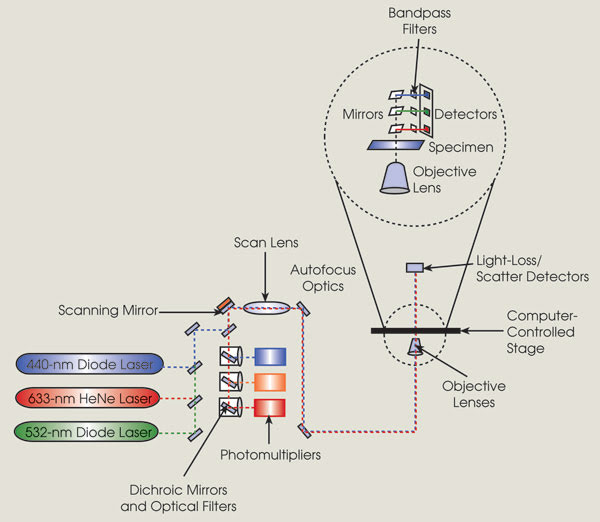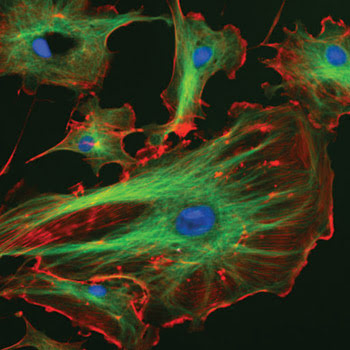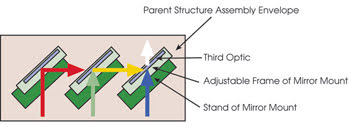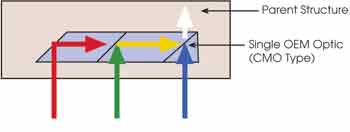Monolithic optics can help simplify and stabilize microscopy optics.
R. Todd Belt and Alan C. Graham, Agilent Inc.
The evolution of microscopy from direct human observation to digital image capture has significantly advanced research in the life sciences. For microscopy, digital cameras, along with image-processing and data algorithms, have allowed observations of many new biological processes.
Although today’s optical designs have evolved to allow complex optical functionality, this added functionality requires the manufacturer or researcher to insert and align a variety of discrete optical components in the optical path (Figure 1). This time-consuming and expensive process adds complexity to the optical path. It also decreases alignment stability while increasing the path length and the number of scattering interfaces.

Figure 1. Instruments such as an imaging cytometer require complicated sets of optics in the optical path.
The next level of microscopy optimization will simplify and stabilize the illumination source, the beam-combining and -splitting optics, and the beam-directing optical assemblies. Simplifying optical integration will help drive down manufacturing costs, reduce bench footprint, improve performance and enable use of microscopy instruments in realistic laboratory environments where contamination of optical surfaces from condensation of volatile organics and other contaminants is an ongoing concern.
Complex monolithic optic (CMO) design can offer significant improvement over the historic approach. This type of design integrates optical building blocks — such as those used for chromatic separation and combination, for beam steering, and for phase and amplitude control — into a single solid-glass optical assembly. All optical surfaces are environmentally isolated because they are immersed in glass, which protects the coatings from environmental degradation.
CMO design already has been used in high-precision semiconductor lithography systems, where three- to five-channel displacement interferometers have replaced traditional optomechanical assemblies for subnanometer measurement of wafer-positioning stages. In this market, complex monolithic optics have resulted in more repeatable production processes, higher accuracy, more stable systems, smaller and lighter assembly, and lower cost.

Figure 2. Microscopes have optics that allow them to be used for many applications, such as fluorescence microscopy. Courtesy of NIH.
Optical assemblies
Researchers use microscopes for a variety of techniques, such as epifluorescence, laser-scanning confocal imaging, flow cytometry, total internal reflection fluorescence, Förster resonance energy transfer, fluorescence lifetime imaging, fluorescence recovery after photobleaching and fluorescence in situ hybridization (Figure 2). To address these diverse applications and techniques, manufacturers use combinations of optical and optomechanical assemblies of mirrors, beamsplitters, filters and prisms to steer, separate and combine the light paths.
Many microscopy applications have a rudimentary requirement to combine multiple wavelength sources. The simplest wavelength combination architecture is a breadboard assembly of discrete optics in separate optomechanical mounts (Figure 3). With precision mounts, breadboard assemblies can have a high degree of accuracy and of alignment freedom, achieved through manual alignment of each precision mount relative to the others. The degrees of freedom afforded by each assembly create a highly random assembly process and a correspondingly high assembly cost.

Figure 3. A typical breadboard assembly for combining three wavelengths uses mirror mounts, beamsplitters and reflection optics.
Incorporating the optical mounts into the base of the housing structure (Figure 4) replaces the manual alignment precision with precision that is machined into the parent structure. This approach restricts the degrees of freedom (for instance, once a mount is incorporated directly onto the parent structure, its ability to move in the X- and Y-directions is no longer limitless) and thus reduces the randomness of the assembly.

Figure 4. An integrated optomechanical design for three-wavelength combination has complex and precise mounting features fabricated into the parent structure.
However, the high-precision fabrication of the parent structure can be more costly than manual alignment of individual optical mounts; and although the degrees of freedom in the assembly are reduced, the assembly maintains an undesirable level of randomness for the most demanding alignment requirements. As a result, the breadboard and integrated optomechanical assemblies are inherently costly as well as susceptible to temporal and environmental alignment instabilities that require constant cleaning, adjustment and realignment for optimal performance.
For example, an individual mirror or dichroic filter mounted in the high-precision optomechanical mount of a breadboard assembly initially can achieve 1-μrad parallelism and 200-μm beam centering. Over time, the interfaces of the optic with the adjustable frame and with the mount to the base plate are subject to thermal cycles and to hysteresis that can degrade the beam parallelism to as much as 500 μrad. The integrated optomechanical design initially can achieve 500-μrad parallelism with 100-μm beam centering; however, as with its breadboard assembly counterpart, the performance can degrade significantly over time and with environmental changes.

Figure 5. In a complex monolithic optic (CMO) design for three-wavelength combination, each suboptic within the assembly is secured to its surrounding optics using highly stable bonding techniques.
In contrast, CMO design uses external and reusable assembly tooling to control assembly tolerances (Figure 5). The tooling enables the tolerances to be controlled precisely during the optical fabrication so that all alignment tolerances are built into the optical components. Each suboptic within the assembly is secured to its surrounding optics via highly stable bonding techniques (thin-layer epoxy, optical contacting) that are not available for metal support structures, enabling a design that achieves better than 25-μrad parallelism while maintaining a 20-μm beam centering, an accuracy that can be held over a wide variety of shipping, storage and operational conditions.
Less alignment drift
In the three-wavelength setup discussed above, the breadboard assembly requires nine mechanical interfaces (three interfaces per optic — the optic to the frame, the frame to the stand and the stand to the base plate), the integrated optomechanical design requires three mechanical interfaces (each optic to the parent structure) and the complex monolithic optic requires only one mechanical surface (the optic assembly to the parent structure). The degree of randomness in an assembly is proportional to the number of interfaces between the optical interfaces, so the probability of optical system failure from alignment drift scales with the number of mechanical interfaces. Thus, as the complexity of an optical system increases, the CMO design advantage increases (Table 1).
 The probability of an optical system failure also scales with the number of beam-to-surface interactions. Nearly all optical surfaces of a complex monolithic optic are immersed in the glass substrate, protecting the interface from environmental degradation caused by particulates or by other surface contamination. Using this type of optic design is not advantageous for the simplest wavelength combination design (two-channel), but the advantage scales quickly with increasing complexity. For the three-channel combiner, using a complex monolithic optic yields a 25 percent reduction in the number of beam-to-surface interactions; for a seven-channel combiner, it yields almost a 70 percent reduction in the number of beam-to-surface interactions (Table 1).
The probability of an optical system failure also scales with the number of beam-to-surface interactions. Nearly all optical surfaces of a complex monolithic optic are immersed in the glass substrate, protecting the interface from environmental degradation caused by particulates or by other surface contamination. Using this type of optic design is not advantageous for the simplest wavelength combination design (two-channel), but the advantage scales quickly with increasing complexity. For the three-channel combiner, using a complex monolithic optic yields a 25 percent reduction in the number of beam-to-surface interactions; for a seven-channel combiner, it yields almost a 70 percent reduction in the number of beam-to-surface interactions (Table 1).
Embedding the optical surfaces into the glass substrate and building the alignment tolerances into the optical fabrication process enable a cost-effective alternative to high-precision optomechanical assemblies. Taking these measures decreases labor for system alignment and lessens manufacturing costs because it eliminates optical mounts and other hardware (screws, pins) required for breadboard and integrated optomechanical assemblies.
CMO design also reduces costs that arise from optical substrates. The optomechanical mounts used in the breadboard and integrated optomechanical assemblies require the optical components to be as much as 25 percent larger than the clear aperture so that the optic can be mounted without degrading optical performance. Complex monolithic optics do not require the optical surface to be mounted dis-cretely, so the optical surfaces must be only negligibly larger than the clear aperture. This simplifies optical paths and allows tight beam spacing and folded beam paths that are not practical with the optomechanical designs. In turn, the overall assembly is smaller and lighter. In the semiconductor lithography market, this optical design approach has demonstrated a 50 percent reduction in total system cost, volume and weight.
Fiber-coupled, multiwavelength complex monolithic optic combiners for microscopy platforms are being introduced in the first half of the year. Later on this year, more complex optical assemblies are planned that include more complex color combination, color separation, beam delivery and polarization management.
The transition of optical microscopy platforms to designs that integrate new optical capabilities mirrors the evolution of displacement interferometers in the semiconductor lithography market a few years ago. Today’s microscopy researchers desire a stable microscope platform with complex optical assemblies that require minimal setup, adjustment, cleaning or alignment.
Meet the authors
R. Todd Belt is a senior R&D optomechanical engineer, and Alan C. Graham is the business development manager, both at Precision Optics, Nano Positioning Metrology Div. at Agilent Technologies Inc. in Santa Clara, Calif.; e-mail: [email protected].